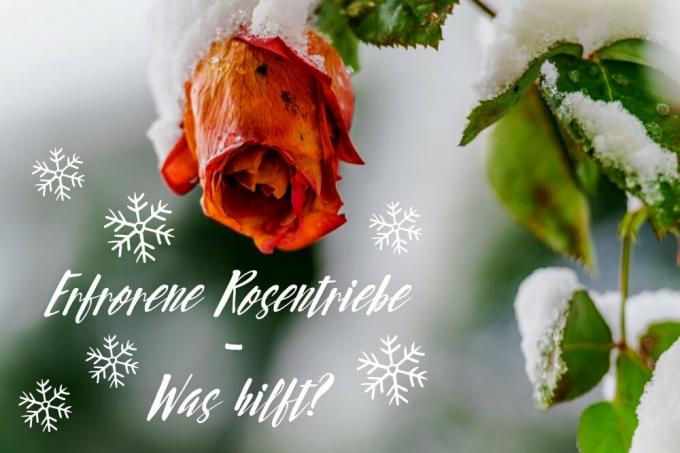
table of contents
- Genetically determined frost hardiness
- Correctly recognize frost damage
- Measures in the event of frost damage
- Often also dried up
- Prepare for winter
- Application of winter protection
- frequently asked Questions
Roses, the queen of flowers, enchant every garden year after year. For a lush sea of flowers, however, there are a few things to consider. Very cold winters in particular can set rose shoots tremendously.
In a nutshell
- The frost hardiness of the individual varieties is quite different
- Frozen rose shoots are brown to black in color and dry
- Roses are not always frozen, but also dried up
- Winter protection is advisable
- Do not prune the roses properly until spring
Genetically determined frost hardiness
The frost hardiness of the different types of roses is always genetic due to the breeding work. Roses with an ADR rating (General German Rose Novelty Examination) are usually more disease-resistant, have more flowers and are more frost-resistant. Various factors have an influence on how the roses survive the winter and, consequently, how high the frost damage to the plants is. These include:
- Weather conditions during the winter
- dry autumn has a beneficial effect on the shoot closure and maturity of young rose shoots
- Rainy and warm autumn delays the ripening process of the shoots
- Frost damage increases
- sick roses are more susceptible to frost damage than healthy plants
- Lack of nutrients, over-fertilization, and fertilizer applications that are too late in the year reduce frost resistance
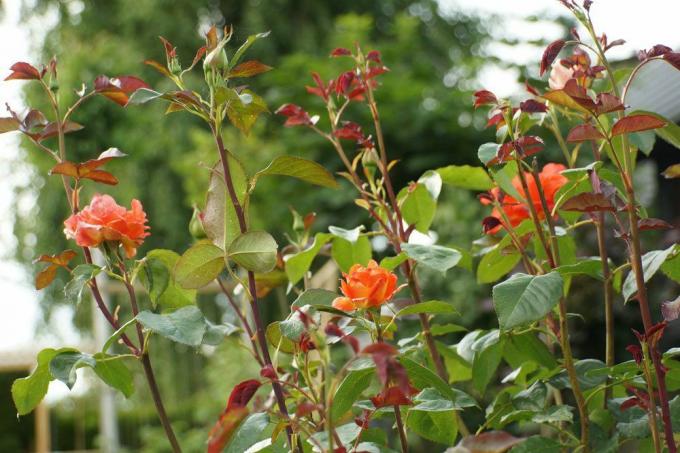
Note: Compared to a refined rose, the wild forms such as the dog rose (Rosa canina) are far less sensitive to frost. They do not need a lot of winter protection in winter and the shoots rarely freeze to death even in extremely cold weather.
Correctly recognize frost damage
The full extent of a cold winter, the more or less existing damage from frost, only becomes apparent in spring. By the end of April to mid-May at the latest, it should be clear whether the roses are still "alive" and have survived the winter with more or less damage. Signs of frostbite are:
- dark brown to black colored rose shoots
- these show no budding
- mostly only individual shoots affected
- In particularly strong winters, it is also possible to freeze back down to the ground
As a rule, a rose that has appropriate winter protection is less likely to show such frost damage. More on that later. Sometimes, however, not all damage is immediately recognizable. Long-term damage can also occur after the new budding. These are expressed as follows:
- yellow to brown discoloration of the leaves during the first growth phase
- Rose shoots stop growing
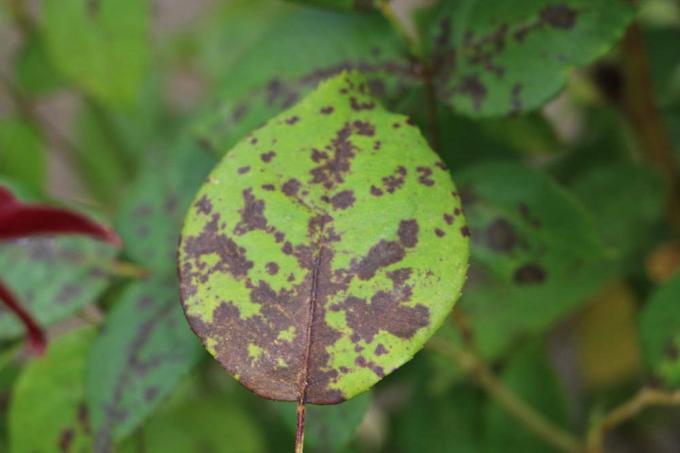
This phenomenon is due to the fact that the roses use the nutrients stored in the shoots for their growth. The conduction pathways of the shoots and roots were damaged by frost and the roses are then no longer able to absorb nutrients from the soil. Only a strong pruning down to the ground can help here. With a lot of luck and patience, the affected rose can regenerate and form new rose shoots at the point of refinement.
Measures in the event of frost damage
If rose shoots have frozen over the winter, only one thing helps: pruning them. Brown or black colored shoots are dead and can no longer be saved. Depending on the damage that occurs to the rose:
- Cut back into the green and living wood
- If the rose shoots are completely frozen back, cut back to the ground
- Budding is possible again if the refining point is underground
- In addition, the plant has to show life
- New growth takes a few weeks
- depending on the weather
- for plant strengthening administration of Nettle manure
- Mixing ratio with water 1:10
- alternatively, horsetail broth is also possible
- Broths can be prepared by yourself
- also available in garden shops
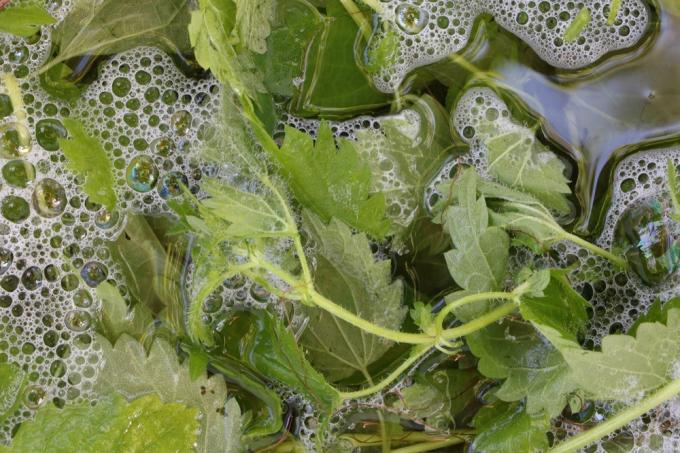
If you are not sure whether a shoot is still alive, you can simply scratch the bark very carefully with your thumbnail. If there is a lush, green tissue underneath, then the rose shoot has not frozen to death.
Tip: When the forsythia blooms in March / April, the actual pruning of the roses can then take place. It should be avoided in autumn.
Often also dried up
Sometimes in the spring, after a more or less severe winter, it seems that the rose has frozen to death. Whereby mostly rose shoots are affected, which are exposed to sun and wind in winter. Shoots that remain in the soil are usually hardly damaged and also show a beautiful green color. However, not only can the roses be frozen to death during periods of frost, but there is also the possibility that they simply dry up. This can easily happen in very heavy frosts. The water contained in the soil freezes to ice. In this case it is no longer possible for the roses to take in sufficient water for their supply. In the spring they are usually dried up. The shoots suffer from drought damage, also known as frost drought. There are no measures that can really help the plant. It can then only be exchanged for a new one.
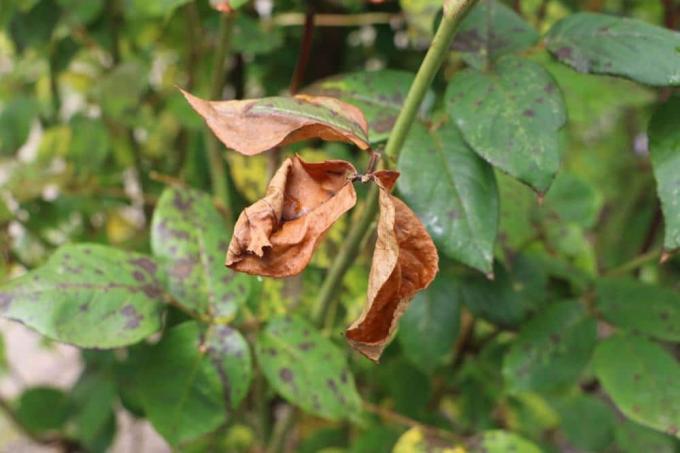
Note: In autumn, roses should be sufficiently watered again before the start of winter so that they can survive the critical time.
Prepare for winter
In order for a rose to survive the winter unscathed, some preparation is required. Proper planting is essential to prevent frost damage. For this purpose, the grafting point is placed five centimeters deep in the earth, then there is a certain protection against severe frosts. In addition, the “queen of flowers” should be thoroughly prepared for the approaching winter in autumn in order to avoid damage from frost as much as possible. The following measures are necessary:
- water thoroughly before the onset of frost
- Avoid waterlogging
- collect all fallen leaves
- Fungal spores overwinter in the soil
- Source of fungal diseases
- thereby weakening the rose, more susceptible to frost damage
- only shorten long and thin shoots by one to two thirds
- remove any remaining flowers
- Remove dead plant parts
- form foci of rot, fungus and infection
- Stop nitrogen fertilization at the beginning of July
- this way, rose shoots can harden properly by autumn
- are then more winterproof
- Use of potash-based fertilizers such as patent potash
- Given from the end of July to the middle of August
- promotes ripening of the shoots, lignifies branches
- Fertilizer is enriched in the cell sap
- protects plant cells from freezing through

Note: A pruning should not be done in autumn, only long and dead shoots, the cut wounds would not close in time. Frost can then penetrate deeply and cause great damage. The best time to cut back is March / April.
Application of winter protection
In winter, the rose is not only doomed by frost or cold winds, but also by intense sunlight during the day and then again by the sharp drop in temperature at night. Mainly the transition from frost to thaw in the months of January and February does not make life easy for the plants. Here in particular, special protective measures are necessary. Of course, snow would be an excellent protection against frost here. However, these days it is a rather “scarce commodity” in many regions. Appropriate winter protection is then essential to prevent damage. However, a few things should be taken into account:
- Do not apply winter protection too early
- Rose shoots need time to mature
- Choose between mid-November and December
- depending on the weather
- ideal is the piling up of garden soil
- alternatively also compost soil
- Pile them up 10 to 20 cm high
- thereby protecting the lower buds (eyes)
- possibly a layer of foliage above it for additional insulation
- Protect shoots from sun and wind
- to do this, apply needle sticks
- Removal of winter protection in spring
- Shoot should then be at least 10 cm high
- Simply spread the soil around the rose
- Dispose of needle sticks

Winter protection should be applied to shrub, climbing and trunk roses. A rose in a tub also needs protection during winter.
Tip: Do not use peat or bark mulch for piling up. The peat stores moisture, which at the same time makes the soil acidic. Bark mulch can also cause damage, as it deprives the soil of the nitrogen that is essential for life.
frequently asked Questions
Cutting back in autumn can do more harm than good to the rose over the winter. The resulting cut surfaces can no longer be adequately closed until winter. The frost then penetrates and damages the rose shoots. Depending on the severity of the frost, the frostbite can be more or less severe. The best time is when the forsythia is in bloom.
First of all, it is important to have sharp scissors so that smooth interfaces are created and the penetration of pathogens is prevented. The actual cut should always be made 5 mm above an outward-pointing eye (bud). The cut is always at a slight angle. This prevents water from collecting and prevents pathogens from entering the wound. Furthermore, sick, dead and weak shoots at the base must be removed.
Here, too, the refinement point must be located 5 cm below the ground. The rose is also piled up 10 to 20 cm high. In addition, the shoots must then be protected with coniferous twigs, reed mats or shade linen. It is best to wrap them properly. They should be properly wrapped to prevent premature budding.
